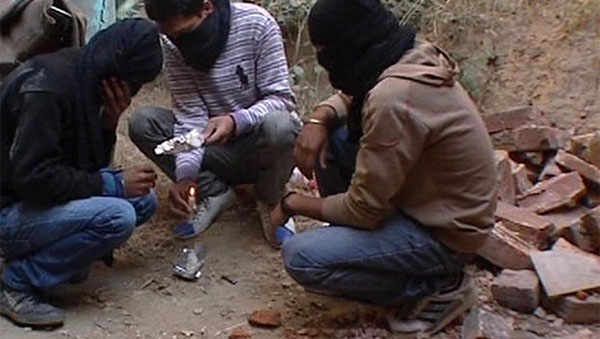
Global and national health officials are concerned that they may be losing the fight against India’s drug problem. Government figures show that there has been a fivefold increase in the number of hauls of illicit drugs in the period of time from 2011 to 2013. There has also been a rise in the number of drugs that are seized by law enforcement in some areas. For instance, in Arunachal Pradesh, there were 426.10kgs recovered in 2011. By 2014 the amount had increased to 5546.80kgs. In Uttaranchal, 2489.64kgs was recovered and by 2014 this had swelled to 110277.55kgs. Mizoram topped the scale for seized illegal drugs with 48209000kgs found that year.
Some of the drugs confiscated include morphine, opium, amphetamine, cocaine, ketamine and cannabis.
Relationship between Poverty and Drug Misuse
Drug and alcohol misuse is a universal problem and occurs in every country and to people from all walks of life but it can occur on a larger scale for those in developing countries, where poverty, lack of education and limited access to medical care or treatment can lead people into a pattern of illicit use and provide little means for them to become sober. Lack of education or career prospects may drive a person to look for illegal ways in which to increase their income, such as drug trafficking. If not, living with conditions of poverty can sometimes influence a person’s mindset so that they are more amenable to the idea of using drugs. 39% of opiate users in Pakistan have only casual work available to them, 32% are unemployed, 15% were part-time workers and only 7% had a full time job.
Opiates and other substances are not only used as a means of income or status, they are also used as pain relievers or medicines to manage inadequately treated medical conditions or as a balm for the stresses of everyday life.
Up to 70% of Young Men Addicted
Youth have similar pressures to those experienced by teenagers in Europe and America. They want to fit in and be liked and accepted by other youth in their group and are susceptible to peer pressure.
The Government of India report that in Punjab, 67% of rural households have a member with at least one drug or alcohol dependency and a totally shocking 70% of young men are addicted to drugs or alcohol.
In Manipur there are around 50,000 drug addicts and half of them are injecting drug users, putting them at risk of contracting HIV via infected needles. India has the third largest HIV epidemic in the world and there are 2.1 million people living with HIV.
Violence against Women and Drug Use
HIV positive people in India face significant health challenges, loss of employment and they may be shunned socially by their communities. Women who are married to addicts are at risk of also becoming infected by the HIV virus. They are also frequently the victims of domestic abuse, with much of the violence initiated by the addict as a means to obtain money to buy drugs. Male members of the family cannot always to counted upon to defend the woman concerned and she may be blamed for causing the drug misuse, hiding it or not seeking treatment for her partner quickly enough.
Women who are themselves addicted are at greater risk of becoming involved in the sex trade and of being raped or excluded from their society, impacting negatively on their children and the wider community.
Indian Youth Abroad at Greater Risk of Drug Abuse
The problem of drug and alcohol abuse is widespread across the globe but can affect Indian youth living abroad specifically. They may have conflicts over culture and differences between familial expectations and local customs and activities. While parents may wish to raise their children according to their traditional Indian heritage, children and young people often want to embrace the lifestyle of other young people around them and they have a risk-taking, experimental attitude. This creates a clash in ideals that can cause stress or the desire to fit in with the crowd and lead some susceptible teens on the road to drugs, alcohol or cigarettes. An American study found that 28% of US born Indian adolescents had used alcohol, 16.5% used cigarettes and 2.5% used cannabis.
Signs of Drug Addiction
If you think your loved one may be affected by addiction, there are several warning signs you can look out for. If you recognise the symptoms of addiction you may be able to get help for them sooner:
- Sudden weight loss (or sometimes gain)
- Dilated pupils or bloodshot eyes
- Changes in appetite
- Changes in sleeping patterns – for instance, sleeping a lot during the day
- A deterioration in physical appearance – for instance, he or she may no longer comb their hair or they might wear dirty clothes
- Slurred speech or poor coordination
- Loss of interest in normal activities, such as going to work
- Secrecy with family members, mood swings, being defensive or violent
- Excessive requests for money without a reason
- Stealing behaviour.






 If Aurangzeb had the intention of demolishing temples to make way for mosques, there would not have been a single temple standing erect in India. On the contrary, Aurangzeb donated huge estates for use as temple sites & .....
If Aurangzeb had the intention of demolishing temples to make way for mosques, there would not have been a single temple standing erect in India. On the contrary, Aurangzeb donated huge estates for use as temple sites & ..... 
 | Quick links
| Quick links